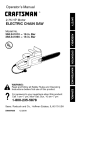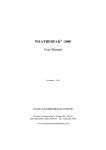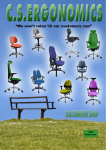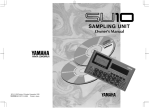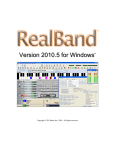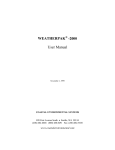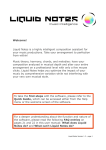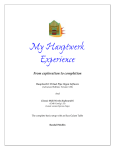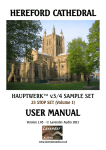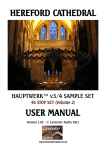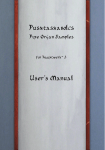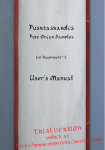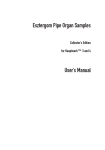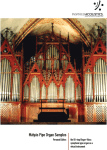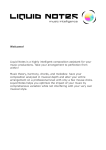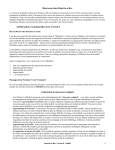Download Hauptwerk Release Notice
Transcript
Hauptwerk 4.2.1 Release Notice
Hauptwerk 4.2.1 Release Notice
Contents
Compatibility, Support and Licensing Policies ...............................................................................................................4
Media, Downloads, Installation and Upgrading ............................................................................................................5
Changes to Hauptwerk ..................................................................................................................................................7
Changes in version 4.2.1 above version 4.2.0............................................................................................................7
Bug-fixes................................................................................................................................................................7
Changes in version 4.2.0 above version 4.1.1............................................................................................................8
Improvements .......................................................................................................................................................8
Bug-fixes................................................................................................................................................................9
Changes in version 4.1.1 above version 4.1.0..........................................................................................................10
Hauptwerk USB key drivers and evaluation/Free Edition 90-day license key ....................................................10
Other improvements ..........................................................................................................................................10
Bug-fixes..............................................................................................................................................................10
Changes in version 4.1.0 above version 4.0.0..........................................................................................................12
Master combination system ...............................................................................................................................12
Audio/MIDI recorder/player ...............................................................................................................................12
Voicing ................................................................................................................................................................12
MIDI sequencing and notation software compatibility ......................................................................................12
Performance .......................................................................................................................................................13
MIDI and hardware compatibility .......................................................................................................................14
Other improvements ..........................................................................................................................................15
1
Hauptwerk 4.2.1 Release Notice
For sample set developers and the Custom Organ Design Module ....................................................................17
Bug-fixes..............................................................................................................................................................18
Platforms .............................................................................................................................................................20
Changes in version 4.0.0 above version 3 ................................................................................................................22
© Copyright Milan Digital Audio LLC 2001-2015
All Rights Reserved
2
Hauptwerk 4.2.1 Release Notice
Overview
Hauptwerk 4.0.0 was a major new version of Hauptwerk, superseding versions 1-3, with its user interface and MIDI
implementations redesigned from the ground up to make Hauptwerk extremely easy and intuitive to use, requiring
almost no technical, MIDI or computer expertise, but without compromising Hauptwerk's flexibility or realism.
There are a huge number of other major usability, functional and performance enhancements above version 3,
based firmly on what organists have told us they wanted from virtual organ software over the past ten years
(covering the majority of features we'd been asked for, in fact), and we hope and believe that Hauptwerk 4 will
hugely benefit every existing virtual organist, as well as helping to broaden the appeal and accessibility of pipe
organs, both real and virtual.
Version 4.1.0 was a maintenance release that added more major new functionality, as well as extensively
improving upon the features of version 4.0.0 and adding support for the latest computer and MIDI platforms.
Version 4.1.1 had various important compatibility fixes and bug fixes above 4.1.0 (especially relating to the
Hauptwerk USB key and its driver).
Version 4.2.0 had some significant performance improvements, some other minor enhancements, and additional
fixes
Version 4.2.1 has some important bug fixes, including one that could affect stability. We strongly recommend
upgrading to it as soon as possible.
The most current source of information about Hauptwerk is the Hauptwerk website: www.hauptwerk.com. Please
have a look there too for updated information, downloads, tutorials, known bugs, and lots more.
3
Hauptwerk 4.2.1 Release Notice
Compatibility, Support and Licensing Policies
This version is fully and seamlessly backwardly-compatible with versions 2 and above, and your settings,
combinations and voicing can be preserved (although if upgrading from version 2 or 3 you have the option to reset
and re-detect your settings automatically using version 4's 'MIDI learn' capability, which we recommend doing for
best results). All sample sets that worked in version 2 and above should work and perform in this version at least
as well as they did in previous versions. Sample sets in Hauptwerk version 1 format can be imported and used in
this version too. It's our intention that all future Hauptwerk versions remain fully and seamlessly backwardlycompatible with this version.
We believe this version is better in every way than previous versions: it's easier to use, more powerful and flexible,
with greater realism and better performance. Since version 4 has been available for more than a year, versions 1, 2
and 3 are thus now considered fully obsolete and are no longer supported. If you have a license for versions 1, 2 or
3 then you must upgrade to a licensed version 4 edition in order to receive support from us.
Reasonably-priced upgrades to version 4 from versions 1, 2 and 3 can be purchased from the Hauptwerk on-line
shop or from your re-seller. In particular, very affordable upgrades are available to the lower-cost version 4 Basic
Edition.
Upgrades between minor Hauptwerk versions (for example between 4.0.0 and 4.2.1) are free to supported users,
but a license upgrade must be purchased to upgrade between major versions (for example between version 3.30
and version 4.2.1). Hence this version is free if you already have a license for version 4.
4
Hauptwerk 4.2.1 Release Notice
Media, Downloads, Installation and Upgrading
We strongly recommend that you read the Hauptwerk User Manual, which includes important prerequisites and
installation instructions, and is included on the Hauptwerk DVD and on-line on the Hauptwerk website, before
attempting to install or upgrade Hauptwerk. Please follow the instructions in the relevant installation section.
In particular, please ensure that you have at least 2 GB of memory, and at least 6 GB of free disk space, otherwise
Hauptwerk's installer may not function correctly. Make sure you have all current operating system updates, and
the latest drivers for your hardware, installed. On the Mac platform you need a 64-bit Intel Mac (any Mac made
since about 2007) running OS X 10.10 (‘Yosemite’), 10.9 (‘Mavericks’), 10.8 (‘Mountain Lion’), 10.7 (‘Lion’), or later.
On the Windows platform, 64-bit Windows 8.1 and 64-bit Windows 7 are our primary, fully supported, and
strongly recommended platforms (*).
A small hardware USB 'dongle', termed the Hauptwerk USB key, is used to license Hauptwerk and some third-party
sample sets for it.
Hauptwerk licenses, license upgrades and evaluation/update DVDs can be ordered from the Hauptwerk on-line
shop or from your re-seller.
The software itself can also be downloaded for free from the Hauptwerk website. The full installer will install
Hauptwerk on the computer if Hauptwerk version 2 or later is not already installed on it, or will upgrade your
existing Hauptwerk installation to the latest version if version 2 or later is already installed. To help keep download
sizes manageable, our website also has a smaller ‘update’ version of the installer that only has the ability to
upgrade an existing Hauptwerk version 4 (or later) installation. In all cases, no settings will be lost when upgrading,
no sample set sets need to be re-installed, and the resulting software installation will be identical regardless of the
media you installed it from (DVD, ‘full’ download or ‘update’ download).
You can obtain the current Hauptwerk software either as a free download or on DVD at a minimal cost. Both are
available via our website. Whether the software functions as licensed software or as an evaluation/Free Edition is
determined only by the presence or absence of the Hauptwerk USB key, and whether it contains a valid license for
the version of the software you have installed.
If you don’t have a license for Hauptwerk version 4 the software will function as a Free Edition/evaluation copy. If
you had an evaluation copy of versions 2-3 installed then the installer will upgrade it to a Free Edition/evaluation
copy of version 4.
If you don’t have a license for Hauptwerk versions 2-4 and you buy a license for version 4 then you will be sent the
necessary Hauptwerk USB key, as well as a copy of the software DVD containing the latest version of Hauptwerk (in
case you need it, but there’s no need to re-install Hauptwerk if you already have this version installed).
If you currently have a license for Hauptwerk versions 2-3 then you need to purchase an upgrade to version 4 in
order to be able to use this version as licensed software. Once you have purchased an upgrade we, or your reseller, will contact you to arrange to update your existing USB key remotely to enable version 4 on it. This is a
simple process that requires exchanging two small files by email, and full instructions will be sent to you following
your order. If your Hauptwerk computer doesn’t have an Internet connection you can transfer the files via a USB
memory stick, writeable CD/DVD, floppy disk, or similar.
Important: If your license is for version 2 or 3 and you don’t update your license for version 4 before installing,
Hauptwerk will revert to running in Free Edition/evaluation mode but allow you to apply the license upgrade at
any time to restore full licensed functionality. A computer can only have one version of Hauptwerk installed on it
at any one time. Once a new version has been installed it isn’t possible to revert to a previous version without
uninstalling Hauptwerk completely (selecting the option to remove all settings and files) then re-installing the older
5
Hauptwerk 4.2.1 Release Notice
version, which would wipe any existing settings. Hence there’s no easy way to revert to a licensed version 2 or 3
installation once version 4 has been installed other than by purchasing a license upgrade.
If you have a license for the smaller Basic Edition and you want to evaluate features of the full Advanced Edition,
simply exit Hauptwerk, then disconnect your Hauptwerk USB key temporarily (never attach or detach the USB key
while Hauptwerk is actually running). When you then launch Hauptwerk again it will allow to you to run it as an
evaluation version, so that you can try out the functionality of the Advanced Edition. Reconnecting your USB key,
then re-launching Hauptwerk, will return you to your licensed Basic Edition. No settings will be lost in the process.
(*) Please note: earlier versions of Windows may still work but we now support them to the extent that we’ll
provide help on them only with issues that can be reproduced on our primary platforms, and we no longer test with
them.
6
Hauptwerk 4.2.1 Release Notice
Changes to Hauptwerk
All Hauptwerk releases since version 2 are cumulative, thus each includes all changes from previous Hauptwerk
versions.
Changes in version 4.2.1 above version 4.2.0
Bug-fixes
Virtual console graphics could occasionally freeze, or cause Hauptwerk to crash (since v4.2.0).
Computer key assignments to functions/buttons, and auto-detection for them, weren't working unless an
organ was loaded (since v4.2.0).
Free RAM indicators and LCD panels wouldn't update during organ loading if loading the organ was
triggered via MIDI or from computer keys (since v4.2.0).
7
Hauptwerk 4.2.1 Release Notice
Changes in version 4.2.0 above version 4.1.1
Improvements
The wind supply model is now available worldwide in the Advanced Edition. (Previously it wasn't available
in the U.S.A.)
Performance: the responsiveness/latency/accuracy of MIDI and background models (including tremulants
and the wind supply model) has been improved significantly, compared to any previous Hauptwerk
version. Note that a small number of MB of extra memory might be used than previous versions (typically
only 4-20 MB, depending on the size and complexity of the virtual instrument's graphical console).
Performance: the CPU load due to console graphics, as well as the load on the first CPU core, have been
reduced significantly. The real-time processing that was previously performed using the first CPU core is
also now distributed more evenly across other available cores.
MIDI compatibility: MIDI input and output buffering are now implemented natively within Hauptwerk for
better performance and improved resilience to lost MIDI messages (especially 'stuck notes' and large
volumes of MIDI output) with MIDI interfaces/drivers that don't have much (or any) internal buffering of
their own. There is a new setting for the buffer size on the 'General settings | General preferences |
Advanced ...' screen tab.
MIDI compatibility: by default, MIDI output sending speed through each physical MIDI port, and USB-MIDI
port, is now limited to MIDI 1.0 standard baud for maximum compatibility with MIDI hardware, controlled
by a new setting on the 'General settings | General preferences | Advanced ...' screen tab. It should be
kept ticked if you're using any physical MIDI cables from MIDI OUT ports, or if any USB-MIDI devices
connected directly via USB behave strangely, lose occasional MIDI messages, or can't process MIDI data
fast enough. Keep it ticked if you aren't sure. It doesn't affect VST/AU or virtual MIDI cables.
Platforms: support added for OS X 10.10 ('Yosemite').
Platforms: support added for the current versions of the following VST/AU hosts: Logic Pro X, Cubase,
Reaper, and GarageBand. Please note that Logic Pro X 10.0+ and GarageBand 10.0+ are now the minimum
compatible versions of those hosts.
Combination system: a new general preference has been added for whether stepper +/- pistons also
synchronize the cued frame number. If ticked, then pressing the stepper + or - pistons also sets the cued
frame number's 100s and 10s digits to match the new current frame's 100s and 10s digits, otherwise the
stepper +/- pistons don't affect the cued frame number at all.
Combination system: 'Registration | Export/view current combinations as text listing' now has an option
to show master scoped combination scopes.
MIDI recorder/player: playback speed is no longer reset when starting playback or rewinding.
MIDI compatibility: MIDI 'NRPN/RPN reset' components are no longer sent, since (although
recommended as best practice) they caused compatibility problems with some sequencers, including
Logic.
MIDI compatibility: support has been added for the MIDI implementation used in recent Phoenix digital
organs with moving draw-knobs.
MIDI compatibility: custom MIDI messages are now sent after the initial reset, so that any resulting output
from consoles/encoders isn't lost in the reset.
Custom Organ Design Module: made compatible with ranks that have protected attack samples but nonprotected release samples (some Sonus Paradisi sample sets).
8
Hauptwerk 4.2.1 Release Notice
Sample set developers: a new optional _General.AudioEngine_BasePitchHz organ definition attribute has
been added. If left at its default of zero, Hauptwerk will attempt to determine the base pitch
automatically from the sample files, as for previous Hauptwerk 4 versions. Only set this to a non-zero
value if you are certain that the value you specify is exactly correct, since an incorrect value would lead to
the organ sounding at the wrong pitch (and probably being out of tune with other instruments and/or any
real pipework).
Diagnostics: raw hex bytes are also logged when logging MIDI output.
Diagnostics: more specific reason is logged if a sample set cache is regenerated when a file can't be
found/read, and if an image file can't be read from a sample set cache.
Bug-fixes
Audio glitches could have occurred very occasionally if both MIDI and audio were routed simultaneously
via VST/AU (since v2.0).
LCD panel output might not have worked properly, or might have corrupted other MIDI output through
the same MIDI OUT port (since v4.1.1).
Echoes from MIDI solenoid-actuated stops could prevent the master crescendo and master reversibles
from turning stops off again (since v4.0.0).
The stepper cue 0XX-9XX pistons weren't lighting up properly (since v4.1.0).
Virtual momentary pistons configured to send MIDI program changes could sometimes suppress them
over-zealously, affecting some Hoffrichter illuminated pistons (since v4.1.0).
Changed master scoped combination scopes weren't always reflected in 'Registration | Export/view
current combinations as text listing' output (since v4.0.0).
The error message text was confusing if loading a pre-v4.1.0 protected sample set that requires the
Hauptwerk USB key (since v4.1.0).
Component installer: if re-installing/upgrading a temperament without re-launching Hauptwerk, the
existing temperament's status could incorrectly show as not present (since v4.0.0).
9
Hauptwerk 4.2.1 Release Notice
Changes in version 4.1.1 above version 4.1.0
Hauptwerk USB key drivers and evaluation/Free Edition 90-day license key
The drivers for the Hauptwerk USB key are no longer installed or updated automatically by Hauptwerk’s
installer and are no longer required for using Hauptwerk in evaluation/Free Edition modes. To use
Hauptwerk in licensed mode, please ensure that you download and install the latest drivers for the
Hauptwerk USB key from the main downloads page on the Hauptwerk website: www.hauptwerk.com.
Hauptwerk version 4.1.0 required a 90-day evaluation/Free Edition license key to be installed and
refreshed each 90 days, in order for Hauptwerk to be able to launch without a Hauptwerk USB key
attached. That is no longer necessary for version 4.1.1 onwards, which can launch indefinitely, with no
need to install or renew any keys.
This version fixes various important compatibility and stability issues relating to the USB key and its
drivers from version 4.1.0.
Other improvements
Using the combination stepper +/- frame functions no longer affects the cued frame (but the 000 function
does still reset the cued frame to 00x).
Combination set and recording 'save as' windows now have the initial (=default/last) filename text
highlighted, so that it can be over-typed immediately, with no additional key-presses.
Hauptwerk never now defaults Hauptwerk VST/AU Link MIDI ports to enabled, to avoid any potential for
compatibility issues.
LCD panel MIDI output messages are now logged in a human-readable form when MIDI logging is enabled.
More detailed information logged for the virtual controls events trigger, and for MIDI events received via
MIDI player/sequencer, when MIDI logging enabled.
Bug-fixes
An organ could fail to load (unload or crash) if particular functions had previously been assigned manually
to piston toolbars in v4.0.0.
Licensing errors could be given incorrectly with a few sample sets (such as the IA Kolozsvar).
Hauptwerk could hang when loading sample sets with exceptionally short release samples (such as the
Prospectum St. Johannes).
The menu function switch settings screen could give error code 0814 if a switch had been configured for
automatic MIDI output in an earlier Hauptwerk version.
There was a slight chance that other open applications could possibly lose data if the computer was shut
down from Hauptwerk on Windows (since v2).
Uni-directional organ continuous control stage switches could fail to trigger (pizzicato stops/couplers with
MDA MW-331 theatre organ).
Master reversibles didn't always capture properly if they already had registrations stored to them.
The organ continuous control percentage LCD line format was incorrectly showing values in range 0-127.
Specified prefix text was also truncated more than necessary.
Non-ANSI characters in recording filenames weren't working properly on Mac OS X (only; since v4.1.0).
10
Hauptwerk 4.2.1 Release Notice
The combination stepper frame sequence (+/-) was incorrect if the number of stepper trigger pistons was
set to less than 10.
If launching without a valid license, the options selected on the edition selection screen might not take
effect until the subsequent launch.
The first high-resolution controllers in a MIDI file could be processed twice, causing the St. Anne's FF
piston to stick on indefinitely. (It has now been fixed to behave as v4.0.0 did, whereby the FF piston can
be turned off by pressing it once, or twice, if it wasn't turned off again within the MIDI file.)
The X-Keys sendScanCode() scripting function was working with Hauptwerk v4.0.0 but not with v4.1.0.
The user guide incorrectly referred to 'scoped' instead of reversible pistons on v4.1.0 page 108.
11
Hauptwerk 4.2.1 Release Notice
Changes in version 4.1.0 above version 4.0.0
Master combination system
The master combination system has been very significantly improved and extended, including new
'reversible' combinations (which toggle one or more stops on/off and can be used as a new and
alternative way to register organs, as well as for implementing 'additive' combinations such as tuttis), a
better-integrated master crescendo, and pistons that light automatically (supporting MIDI output to
illuminated MIDI pistons) whenever the current registration matches their stored registrations. The new
controls can all be found on the 'Registration' large control panel. Hover over each of them from a brief
tip on what they do and how to use them. The master crescendo handles stops more intelligently too. All
of the new functions are accessible via MIDI, and status information is available via MIDI LCD panels.
A new menu function 'Registration | Export/view current combinations as text listing ...' is available that
generates and displays an HTML file listing the non-empty registrations currently stored to each
combination (with raw XML data in an accompanying XML file to allow easy parsing by third-party tools).
Stepper +/-/000 menu functions are now accessible from up to four MIDI pistons via additional 'inp 3/4'
entries on the 'Organ settings | MIDI/key triggers for master pistons and menu functions' screen.
A floating division's keys are no longer reset in the specific situation where you switch routes for the
division and the same target virtual keyboard is selected for both the previous and new routes.
'All divisions' floating division route selector functions are now 'stateful' (buttons light up and allow MIDI
output).
Audio/MIDI recorder/player
The MIDI player now has new playback play/pause/resume, fast-forward and rewind functions, playback
speed adjuster, and position and total length displays (on control panels, accessible via MIDI, and with
status information available via MIDI LCD panels).
There are new MIDI/toolbar-assignable options to arm audio and MIDI recording, to prompt for recording
filenames, and to stop (instead of pausing) when playback finishes, plus a new function to start
audio/MIDI recording according to those options.
If prompting for recording filenames, Hauptwerk now does so when recordings stops (instead of starts) to
avoid the need to acknowledge/edit a name when you might subsequently cancel the recording/take.
When recording, Hauptwerk now appends as little as possible to manually-specified recording names to
keep them concise. There's also a new general preference for organizing recordings automatically in subfolders by organ name or recording name.
The MIDI player has been made much more compatible with MIDI files saved by third-party sequencers
(including Logic, PowerTracks and Cappella) and also with MIDI files that don't fully adhere to the MIDI
standard.
Voicing
There is a new voicing screen to adjust rates of modeled tremulants (Advanced Edition only). It's
accessible via the 'Organ settings' menu, or by right-clicking on a tremulant or tremulant-affected stop.
MIDI sequencing and notation software compatibility
A new menu function 'Recording | View MIDI recorder/player/sequencer MIDI implementation (for this
organ) ...' is available that generates and displays an HTML file showing the full supported implementation
12
Hauptwerk 4.2.1 Release Notice
for the organ. (It can be found in [Hauptwerk installation
folder]/HauptwerkUserData/OrganMIDIImplementationExports, with raw XML data in an accompanying
XML file to allow easy parsing by third-party tools.) The user guide now refers to this function, rather than
attempting to list the implementation generically in full.
The MIDI recorder/player/sequencer MIDI implementation has been changed to record control changes
for swell pedals and master volume, in preference to NRPNs, since some sequencers allow graphical
editing/shaping of CC data but not NRPN data. Use the new 'Recording | View ...' menu function to view
the implementation for any given organ. (The v4.0 NRPN implementation is still fully supported.)
The MIDI recorder/player/sequencer MIDI implementation has also been extended to allow stepper,
master general and master scoped pistons and master crescendo events easily to be entered manually
into MIDI files/projects, if you prefer, and if independence from combination sets isn't important to you.
Use the new 'Recording | View ...' menu function to view the implementation for any given organ. If you
prefer to work that way with a MIDI file that was recorded by Hauptwerk then you will probably want to
use your sequencer to delete the stop/coupler/tremulant on-off events (NRPNs and sys-ex) from the MIDI
file before inserting your combination events. Manually-entered combination events may also provide a
convenient way to adapt a MIDI file that was recorded with one organ for use with another. (Combination
system events are received/played only, not sent/recorded, so that MIDI files remain independent of
combination sets by default.)
There are various new MIDI control change and MIDI program change 'notation' event types, available via
switch settings screens, for convenient and easily-memorized hand-configuration for use with handentered MIDI events in notation (or generic MIDI sequencing) software, such as Sibelius and Finale, in
case you prefer to work that way. These are relevant only if you are controlling Hauptwerk via a 'Console
MIDI IN' port on the MIDI ports screen (and are not part of the special, fixed MIDI
recorder/player/sequencer implementation that applies to the 'Sequencer MIDI IN' port).
Master combination (stepper, master generals, master crescendo, etc.), master coupler and floating
division selection events are now processed strictly synchronously (in exact incoming event order) for
compatibility with notation software.
The user guide has a new section covering how to use Hauptwerk with notation software.
Performance
Audio engine performance has been improved very significantly, so that there's much less noticeable
'drying up', much less CPU load when the polyphony limit is exceeded, significantly less polyphony needed
overall for wet sample sets for realistic results, better load-balancing, and polyphony should never run out
completely in times of continuous extreme polyphony overload. Overall, a significantly less powerful
computer (CPU) should be needed to achieve realistic results, especially for wet sample sets. Polyphonyrestricted Hauptwerk editions (the Free and Basic Editions) should now be capable of much more realistic
results with wet sample sets, and with larger registrations. Important note: you might need to re-adjust
your polyphony limit settings to get optimal results for each organ (since release samples are now faded
more gently and progressively, in some cases you might find you even need to reduce polyphony limit
settings a little to prevent CPU overload, but you should still get very significantly better and more
realistic results overall).
Audio engine performance has also been improved very significantly when using multi-channel audio,
especially with large numbers of audio outputs or CPU cores.
Performance: the maximum amount of memory usable on all supported 64-bit platforms (including all
supported versions of OS X and Windows) is now typically at least 85% of the computer's physical RAM
(for computers with 8 GB or more), usually now without risk of performance issues from the operating
system 'paging' Hauptwerk's data out to disk. In particular, this typically allows significantly larger sample
sets to be used on OS X and significantly increases resilience to audio glitches on all platforms. Please note
13
Hauptwerk 4.2.1 Release Notice
that the 'free' memory figures shown in Hauptwerk now report the remaining amount of physical memory
that Hauptwerk is not yet using, from the portion it might potentially reliably be able to use, even though
other applications may be using some or all of it. Hence if you are using other performance-sensitive
applications simultaneously, such as MIDI sequencers, then you should ensure that you leave sufficient
memory free for them.
Audio engine performance has also been improved for HyperThreaded CPUs on OS X.
Normal organ loading times have typically been reduced on computers that have SSDs or fast hard-drives
and that also have 4 or more CPU cores, as well as for sample sets that use most of the computer’s
memory. (Note: all sample set data caches will be regenerated the first time this version is used.)
Background model (tremulants etc.) smoothness/resolution has been improved in times of high CPU load.
(Note: some sample sets might require very slightly more memory; typically only a very few MB extra.)
MIDI output is now sent or suppressed more intelligently, potentially significantly reducing the amount of
MIDI output traffic sent by Hauptwerk (and reducing MIDI buffering/'ciphering' issues).
Performance has been improved a little with Windows DirectSound drivers, and spurious spikes that could
occur on Hauptwerk's CPU meter with DirectSound drivers have been eliminated.
Performance has been improved on recent CPUs.
MIDI output is now sent or suppressed more intelligently, potentially significantly reducing the amount of
MIDI output traffic sent by Hauptwerk (and reducing MIDI buffering/'ciphering' issues).
An additional polyphony testing organ (PolyphonyTestingOrgan-For4GBMemoryOrMore) is included, for
testing static polyphonies up 30500. (Note that the measured polyphony may be slightly lower with the 4+
GB organ than the 2+ GB, since its additional complexity places some additional stress on a computer's
memory bus.)
Initial organ loading times (when re-/generating a sample set’s cache) have been improved significantly
(typically by 20-25%) for organs licensed via the Hauptwerk USB key.
Hauptwerk has been tuned to perform a little better on CPUs with smaller amounts of CPU cache.
The 'Reduce relay/MIDI/tremulant/model response/accuracy/quality for max polyphony?' organ
preference is now also enabled for CPUs with 9-12 virtual CPU cores.
MIDI and hardware compatibility
Support has been added or improved, including auto-detection, for many extra expression pedal, piston
and stop MIDI implementations found in digital/electronic organs and other MIDI hardware. Try autodetecting your MIDI controls again if you couldn't get them to work with Hauptwerk previously, ensuring
that you have the appropriate option selected for the MIDI hardware/console type on the 'General
settings | General preferences' screen.
Full native support has been added for Novation Launchpads (using their default MIDI implementation),
including auto-detection, automatic MIDI output, LED color selection, and support for multiple Launchpad
units. Novation Launchpads can provide a very convenient and cost-effective means for controlling virtual
stops and pistons. Make sure you have your Launchpad’s entries selected for both Console MIDI IN and
Console MIDI OUT on the ‘General settings | MIDI ports’ screen then use right-click auto-detection to
configure stops or pistons for Launchpad buttons.
Theatre organ virtual 2nd touch divisions can now be played independently via MIDI note-on/off events
(but they necessarily remains linked if velocity or aftertouch are used).
Theatre organ 2nd touch can now be controlled by a MIDI keyboard's channel aftertouch and key velocity
simultaneously. Re-auto-detect your virtual theatre organ keyboards with 2nd touch if applicable. Two
14
Hauptwerk 4.2.1 Release Notice
modes are available on the keyboard settings screens: ‘Velocity or chan aftertouch >=threshold
(aftertouch: all keys)’ (the default) and ‘Velocity or chan aftertouch >=threshold (aftertouch: held keys
only)’.
MIDI output is now sent or suppressed more intelligently, potentially significantly reducing the amount of
MIDI output traffic sent by Hauptwerk (and reducing MIDI buffering/'ciphering' issues).
'MIDI note/NRPN-on piston' switch event types now send latching MIDI note-on/off output to control
illuminated/solenoid-actuated MIDI pistons/stops properly with default 'automatic' output.
It's no longer required that solenoid-actuated/illuminated MIDI stops all be in an off state prior to
launching Hauptwerk.
Number keypad keys can now be used to trigger virtual switches/pistons, independently from their main
keypad equivalents (if NumLock is on). Return and Space keys can also now be used (but can't be autodetected). Up, Down, Left, Right, PgUp and PgDn keys are disallowed, since it isn't possible to make them
work reliably.
MIDI output from a virtual control is now suppressed when auto-detecting the control, to avoid MIDI
hardware behaving incorrectly.
If needed, Hauptwerk re-tries accesses to its USB key up to 10 times, in case your computer's USB bus is
temporarily busy or overloaded, logging a warning if it took more than one attempt.
MIDI learn now guesses the key shift to apply for pedalboards that start with MIDI note numbers 0, 12 or
24 (to allow for DIY pedalboards wired to 128-pin MIDI encoders).
High-resolution MIDI NRPN and RPN values (MSB/LSB pairs) are now supported for input and output for
control panel slider functions and for organ expression pedals/sliders/knobs. (The MIDI
recorder/player/sequencer MIDI implementation also now supports MSB/LSB pairs for NRPNs and the
sys-ex format has been extended to send continuous control values as MSB/LSB pairs, whilst maintaining
compatibility when receiving/playing MIDI events recorded with Hauptwerk v4.0.)
There is a new 'X-Keys one-shot character code' event type for virtual switches/pistons, with autodetection support, for the X-Keys SendUnicode() scripting function (but only for key codes supported by
Qt: http://doc.qt.nokia.com/4.6/qt.html#Key-enum ).
The user guide has a new section covering how to configure Hauptwerk to be played live from a digital
organ console.
(Note: MIDI hardware developers please see the user guide for changes to the MIDI console status output system.)
Other improvements
If configured MIDI or audio devices are disconnected/unavailable when Hauptwerk launches, a prompt
now gives the option to mark the devices as temporarily 'offline' whilst retaining settings for them, or to
clear all settings relating to them. (MIDI ports are never now re-defaulted to 'all/any enabled ports' to
avoid unexpected results.)
When Hauptwerk launches, if new usable audio or MIDI devices are found (that haven't been connected
previously) then Hauptwerk automatically shows the MIDI ports and/or audio outputs screen, in case you
want to use them with Hauptwerk.
Automatic weekly backups are now made to [computer account home
folder]/Hauptwerk/AutomaticBackups by default, when Hauptwerk exits. A new general preference
allows the behavior to be disabled, or the frequency changed. Also, if resetting settings via either
configuration wizard, or resetting voicing, or reverting settings to factory defaults, or restoring a backup,
or if devices are re-defaulted after previous hardware is missing, or launching a new version of Hauptwerk
for the first time, Hauptwerk automatically and transparently makes a full backup first to the same folder.
15
Hauptwerk 4.2.1 Release Notice
Auto-detection/configuration of MIDI output from virtual switches/pistons now forces a specific MIDI
OUT port to be selected (an attempt is made to guess a reasonable default), rather than defaulting to 'all
enabled ports' as previously, to avoid unexpected results.
Protected sample sets that were previously only compatible with licensed editions, but which aren’t
licensed individually via the Hauptwerk USB key, are now also compatible with the Free Edition and
evaluation installations of Hauptwerk (subject to any memory and other limits of the edition or computer
hardware).
Advanced LCD and custom MIDI message screens no longer allow 'all enabled MIDI OUT ports', to avoid
unexpected results. Important: please update their port settings manually accordingly if relevant.
There's a new entry ‘Show "Load Organ" selection screen’ in the 'Load organ when Hauptwerk starts'
general preference, which is selected by default for new installations. The behavior can also be changed
via a new tick-box on the 'Load Organ' screen.
There's a new View menu and control panel right-click option to change the color/style of control panel
data displays (globally).
Release sample amplitude modulation is now applied automatically for multi-release pipes that have been
sounding for only a tiny number of milliseconds, to avoid a 'blip' in sound from bass/melody couplers as
keys of a chord are pressed at very slightly different times.
Bass/melody couplers no longer re-trigger a note in the specific circumstance that the highest/lowest key
of a briefly-played chord is released immediately (whilst still allowing for legato ascending/descending
coupled lines).
When applicable, switch auto-detection 'Toggle …' and 'Send matching MIDI output' options now
remember their last states.
The last-operated cued object type (as shown on the 'Cued favorites (all types)' mini control panel and in
the corresponding LCD panel line format) now remembers its state if an object is cued, selected, or
assigned (by any means) when audio/MIDI are active.
The combination set browser now sorts default CombsNN … entries to the bottom of the list for
readability. Likewise, polyphony testing organ entries are sorted to the bottom of the organ list.
The keyboard semitone-step key shift range has been extended to +/-24 semitones.
Set and Scope now cancel automatically when loading a combination set.
The MIDI hardware/console type setting is now also available on the general preferences screen, so that it
can be checked/changed without needing to re-run the General Configuration Wizard.
There's a new general preference to default to favorite combination set and temperament 01 when
loading an organ.
The component installer now uses the same disk/SSD for temporary file extraction as the sample set's
final destination (HauptwerkSampleSetsAndComponents), to cater for small SSDs used for organ caches,
and possibly for improved installation speed.
Hauptwerk's installer is now packaged as two versions for download: InstallHauptwerk and
UpdateHauptwerk (the latter of which requires an existing v4+ installation), to keep download sizes for
upgrades more manageable. (Whichever you use, the resulting installation will be the same, and
InstallHauptwerk still has the full ability to perform any type of installation or update, as before.)
Since Hauptwerk v3.30 the minimum polyphony limit setting (256) was too high for some older singlecore/32-bit PCs with all realism features enabled, so 128 is now also allowable.
16
Hauptwerk 4.2.1 Release Notice
Hauptwerk and its installer are now signed so that they run on OS X 10.8 and later without needing to
bypass OS X Gatekeeper.
Accessibility support is now enabled within the multi-platform library that Hauptwerk uses (on Windows;
it was already enabled on OS X), and for the Java versions that Hauptwerk's installer can use, for screenreader support for visually-impaired users. (On Windows, ensure the latest Java version from java.com is
installed prior to running the installer if screen reader support is required.)
When first launched on Windows, if no ASIO drivers are available then DirectSound drivers are now
preferred above the Hauptwerk VST Link as the default audio device.
Control panel sliders can now be double-clicked to reset them to their default values.
The clickable area of the 'x' close buttons on large control panels has been enlarged so that they're easier
to use from touch-screens.
The virtual switch/piston auto-detection screen now only displays options that are relevant for the switch
and for your system. (For example, no MIDI output options are shown if no MIDI OUT ports are enabled,
and Novation Launchpad options are only shown if a Launchpad is connected.)
Static LCD label text is now handled via the new 'Fixed, user-defined label text' line format on the renamed
'Organ settings | Advanced MIDI applications | LCD panel control (for this organ)' screen. The previous
separate dedicated screen for LCD label output has been removed and settings from it are not migrated
(since we're not aware of any people having used it). If you were using it, please manually insert entries
for those LCD panels using the renamed screen and new line format.
When importing Hauptwerk v1 organs, the piston switch name format has been neatened. (Re-import
your v1 organs if you want this change to take effect.)
The Custom Organ Design Module (CODM) has been changed to generate combination names in a more
user-friendly format, since they're now visible via 'Registration | Export/view current combinations as text
listing ...'. (CODM organ definitions will need to be regenerated for the change to take effect.)
The Hauptwerk license agreement now specifically clarifies that a public installation license isn't needed
for occasional/temporary public use.
The installer and component installer have been made more resilient to partly-corrupted/partial existing
installations and file permission/ownership issues. (Note: to fix existing file permissions issues, after
running the installer advanced users may open [operating system Applications/Program Files
folder]/Hauptwerk Virtual Pipe Organ/InternalResources/CheckAndFixFilePermissions.sh/bat in a text
editor and follow the instructions inside the file.)
Hauptwerk's log (accessible via the Help menu and included in diagnostic files) includes various extra
items of information that's useful to help us diagnose any technical or performance issues you might be
having.
The sequencing/VST/AU tutorials have been updated, removed from the main Hauptwerk user guide, and
moved to the Hauptwerk website.
The installer’s filename now includes the Hauptwerk version number, to help avoid confusion.
Backups (whether automatic or not) may now be cancelled.
(Plus there are lots of other minor usability, cosmetic, documentation, installer, 'resilience', diagnostic and internal
improvements.)
For sample set developers and the Custom Organ Design Module
In organ definitions and Custom Organ Design Module organ definitions the maximum virtual console
screen/sizes resolutions, maximum image dimensions, and all associated attribute ranges have been
17
Hauptwerk 4.2.1 Release Notice
increased from 2048 x 2048 to 8192 x 8192 pixels to accommodate recent ultra high-resolution monitors
(such as Mac 'Retina displays').
MySQL integration functionality has been completely and permanently removed from Hauptwerk.
(Unfortunately licensing costs and requirements are now such that it isn't commercially viable for us to
continue to offer the option.)
Out-of-range organ definition attribute error messages (804/805/806) now also show allowed ranges.
(Note that organ definition files are still only validated when you load the organ via the 'Design tools'
menu, so it's essential that you load organs that way when developing/testing them.)
HauptwerkOrgan and HauptwerkTemperament are now accepted (and preferred) as valid alternative
filename extensions for component packages, for user-friendliness.
There have been various major improvements to the sample set protection system, including automatic
loss-less compression of sample files when protecting them. Sample sets protected by this version are
likely to load around 80% faster (five times as fast) when generating their caches, compared to sample
sets protected using earlier versions. Hence you may wish to re-protect your existing sample sets to take
advantage of these benefits. Please contact us for the relevant details if you are a sample set producer
using the sample set protection system.
(Sample set developers please see also the appendix in the updated version of the Creating Sample Sets for
Hauptwerk guide for full details of relevant changes for this version.)
Bug-fixes
Loading an organ with more or less multiple screen layouts (portrait etc.) after another could cause a
crash/failure.
Organs with virtual controls with different image elements on one screen layout compared to another
could crash when switching layouts.
Under certain circumstances sample set files could get lost/deleted when re-running the Hauptwerk v4.0
installer, especially due to file/permission/timing-out issues and when moving folder locations on
Windows.
Theatre organ second touch wasn't being recorded properly by the MIDI recorder.
'Free GB' memory estimate figures on control panels could be slightly too high (although please note that
they aren't intended to correspond to memory figures in the Windows System control panel or OS X’s
Activity Monitor).
Johannus stop switches could misbehave under certain circumstances.
The 'Exit Hauptwerk' and 'Shut computer down' MIDI/key trigger labels were back-to-front.
Recorded MIDI file timing could drift very, very slightly relative to audio recordings.
The MIDI player didn't support Hauptwerk v3 MIDI note-on/off messages for stops properly (MIDI note
numbers were incorrect, causing the wrong stops to operate).
Multiple logical audio outputs with non-unique or null aliases could cause recorded audio files to be
invalid.
MIDI program change pistons sending certain specific values sometimes weren't being auto-detected.
Hauptwerk wouldn't necessarily prompt to save combinations if they'd been changed via a 'programmer'
board on the virtual console.
The MIDI output option to suppress echo wasn't working for 'stateful' menu functions (such as master
couplers).
18
Hauptwerk 4.2.1 Release Notice
There was an unnecessary restriction that a maximum of one LCD panel could be inserted on the 'General
settings | Advanced MIDI applications | LCD panel control ...' screen.
Master combination system functions weren't working properly when triggered/embedded in an organ
definition, and could sometimes get triggered twice (such as the MDA Salisbury stepper pistons).
MIDI output switch states could be wrong if virtual switches within an organ definition were connected in
a particular way (such as some Lavender Audio Hereford couplers).
Slash characters in logical audio output aliases, or in manually-specified audio or MIDI filenames, could
prevent audio/MIDI recordings being made.
Voicing values could occasionally be saved very slightly inaccurately on Windows (only).
The cancel button wasn't visible on the backup-restore wizard on OS X.
Spurious file extraction errors (corruption / 'CRC' / 'unexpected end of archive' errors) could occasionally
be given when installing some sample sets (mainly reported with Sonus Paradisi sets). The version of the
third-party archive extractor that Hauptwerk uses has been updated, which appears to have addressed it.
The main Hauptwerk window could become wider than necessary when switching organs if the first
piston toolbar or a default mini control panel was docked in certain locations but closed/hidden.
The master general cancel function wasn’t taking into account the user preference for a switch defaulting
to the ‘on’ state.
The master crescendo frame number displayed in the status bar and on LCD panels didn't change
perfectly in synchronization with the corresponding control panel values.
MIDI output switch states could be sent several times unnecessarily from organs with multiple jamb
console tabs, possibly leading to incorrect Johannus stop states.
Certain specific MIDI sys-ex messages were incorrectly being ignored if MID master fine-tuning was
enabled.
MIDI sys-ex messages being received exactly when Hauptwerk reset could result in sys-ex not working
until MIDI was stopped/started again (which could affected some Johannus console controls).
Switch settings screens weren't allowing zero for NRPN numbers with the NRPN-on event type.
Sample files with uppercase filename extensions weren't working properly in the Custom Organ Design
Module.
Certain rarely-implemented incoming MIDI events could cause the MIDI event stream to be corrupted on
OS X (since Hauptwerk v2).
Hauptwerk could very occasionally crash on OS X when using multi-channel audio with very large numbers
of audio outputs or CPU cores (since Hauptwerk v2, due to a third-party bug).
Hauptwerk could crash, or abort organ loading, if more than 12 logical audio outputs were put in a group
with a 'tone matching' algorithm selected (since Hauptwerk v2).
The audio outputs settings screen could crash if an alias was edited immediately before selecting device
channels (since Hauptwerk v2).
Hauptwerk crashed if MIDI files were played whilst logging MIDI.
Hauptwerk could crash when reverting all settings to factory defaults.
'MIDI active' and 'audio active' MIDI status switch output events weren't being sent in 'off' states when
stopping MIDI/audio (since Hauptwerk v2).
19
Hauptwerk 4.2.1 Release Notice
The IsOrganReady console status output system variable wasn't being sent with the value false/0 when
stopping MIDI/audio.
The original Hauptwerk v1-format MDA Willard Martin Harpsichord wouldn't import (but the v2+
component installer version of the sample set worked properly).
Since v4.0 there was a very slight chance that disabling a MIDI port then later re-enabling it might have
caused MIDI settings that used it to start using a different enabled port instead.
The 'Boom' audio enhancer utility on OS X returns invalid channel names for its virtual device, which
caused Hauptwerk to crash.
Excessively steep filters specified in an organ definition could cause a crash if their effects were
exaggerated via the voicing screen (since Hauptwerk v2). A meaningful error message is now reported
when voicing instead.
The Sonus Paradisi Caen v2 Orage lever was incorrectly sending MIDI output when low virtual pedal keys
were played.
Text containing long file paths could wrap incorrectly in message box screens on OS X (only; since v3.30).
There was a slight chance that auto-detection could be fooled by incoming MIDI events occurring exactly
as the auto-detection screen was closing after clicking the 'Done' button.
Invoking the Custom Organ Design Module compiler more than about 65 times caused it to stop working
or crash until Hauptwerk was re-launched.
Disabling combination set auto-compacting didn't produce a fully expanded XML format.
Custom Organ Design Module coupler codes that referred to non-existent divisions could cause a crash.
Text on some screens could be truncated under certain circumstances.
If theatre organ 2nd touch keyboards weren't previously designated as such and an organ definition
update changed that then 2nd touch keyboards might not have been accessible.
If audio output channels had been mapped non-uniquely, the text of info message 2319 in the log was
slightly misleading.
Floating division route selection controls for floating divisions 3, 4 and 5 embedded in organ definitions
wouldn't have updated their states properly.
X-Keys key code macros that included modifiers (SHIFT, CTRL, etc.) couldn't be used to trigger virtual
switches/pistons.
Progress indicators sometimes weren’t refreshing properly on Windows.
Platforms
On the Mac platform: support has been added for OS X 10.9 ‘Mavericks’. OS X 10.7 ‘Lion’ is now the
minimum version on which Hauptwerk will run. Older PowerPC Macs and early 32-bit-only Intel Macs are
no longer compatible.
On the Windows platform: support has been added for Windows 8.1. Our primary, fully supported
Windows platforms are now 64-bit Windows 8.1, 8 and 7. 32-bit Windows 8.1, 8 and 7, 32/64-bit
Windows Vista and 32/64-bit Windows XP may still work but we now support them only to the extent that
we’ll provide help on them with issues that can be reproduced on our primary platforms, and we no
longer test with them. The oldest Intel CPU on which Hauptwerk will run is now the Pentium 4, and the
oldest AMD CPU is the Athlon 64 (or compatible models).
20
Hauptwerk 4.2.1 Release Notice
(It is unfortunately sometimes necessary for us to drop support for the oldest platforms in order to be able to
support and optimize for the latest platforms properly.)
21
Hauptwerk 4.2.1 Release Notice
Changes in version 4.0.0 above version 3
Since so much of Hauptwerk's user interface was redesigned from the ground up, we're not going to try to give an
itemized list of every detailed change. Instead we thought it would be more helpful and readable to summarize the
notable ones, only going into full detail if there's something you specifically need to be aware of. Please (re-)read
through the Hauptwerk User Manual to learn how to use the new features and new user interface.
So here are some of the highlights first:
Hauptwerk has always aimed to provide the most realistic model possible of a pipe organ on current computer
hardware. For version 4 we tried to make the entire experience of using and setting up a well-integrated, powerful
and flexible virtual organ system extremely quick, easy, and intuitive, even for those with little or no MIDI,
computer or technical experience or inclination. Hauptwerk now automatically detects and configures MIDI
settings for most makes and models of MIDI organ console and MIDI hardware. If you're using a theatre organ, it
will even set up second-touch for you! Right-clicking on a virtual control allows its MIDI settings to be configured
(automatically or manually). You can alternatively access the (redesigned) MIDI settings screens via the menu, as
before.
Real-time performance and activity meters and indicators and real-time adjustments make diagnosing and
rectifying any performance and configuration issues quick and self-explanatory. If you have a performance
problem you should be able to see instantly what's causing it (a meter will go into the red) and how to correct it.
The meters also show clip indicators so that you can check that your recordings were perfect.
Hauptwerk's user interface was redesigned from the ground up to be ultra-intuitive, with clearly laid-out control
panels bringing all related functions together so that it's immediately obvious how functions are used, how they
relate to each other, the functions that are available, and how to configure those functions for MIDI operation. For
example, the 'Audio, MIDI and Performance' control panel shows audio CPU load, RAM usage, sound delay,
polyphony usage, audio levels, sample rate and MIDI channel activity indicators and allows you to adjust
polyphony limits and audio levels in real-time. Hovering over each item on a control panel gives a concise,
meaningful explanation of its function and usage and right-clicking shows related functions.
Settings and settings screens were completely redesigned to make them intuitive, without losing flexibility.
Settings affecting a given object are now stored in at most one place (no longer are there organ settings and
general settings that both affect a given virtual control, for example) and all MIDI settings and preferences are
entirely organ-specific, unless they specifically relate to loading organs. Thus you can now configure a given MIDI
piston to trigger a particular Hauptwerk master general combination for one organ, but instead to trigger a virtual
combination piston included natively within a different organ, for example. This allows you to make the best use of
your MIDI hardware according to the functionality and style of each virtual organ.
MIDI settings screens now work in real-time: you can open several at once and see and test the effects of changes
instantly, with real-time MIDI activity indicators showing which virtual controls or functions are being triggered. So
if you accidentally assign a given MIDI piston to both a virtual piston and a virtual stop then you can immediately
identify and rectify the issue, using the per-object MIDI activity indicators as guides. These make diagnosing any
MIDI configuration issues very quick and easy.
Wizards help you to get Hauptwerk and each virtual organ set up correctly, quickly and easily.
Hauptwerk's user interface is also now optimized throughout for touch-screen use. Touch-screens provide a
popular, convenient, intuitive and cost-effective way to control multiple virtual organs (most often used in
combination with MIDI keyboards and MIDI pistons). The control panels make all of Hauptwerk's key functions
readily accessible by touch and give clear visual feedback of all associated statuses. There are many 'mini' dock-
22
Hauptwerk 4.2.1 Release Notice
able control panels, with all control panel window positions being stored separately for each organ, so you can lay
them out optimally according to the features and layout most appropriate for each particular virtual organ.
Similarly, there are also customizable, dock-able 'piston toolbars', which remember the functions you assign to
them, and their positions, separately for each organ.
Virtual console displays now support zooming, scrolling and full-screen mode to make best use of your valuable
screen space. Virtual organs can optionally support multiple screen orientations and aspect ratios too (when
supported by the virtual organ). To see it in action: select the left or right stop jamb virtual console pages in the
included St. Anne's organ and drag the window between a wide shape (landscape) and a tall and narrow (portrait)
shape. The stop jamb will toggle automatically between landscape and portrait layouts.
Hauptwerk can now natively record and play back MIDI files, completely independently of any MIDI settings or
hardware. So you can now record a MIDI performance using whatever MIDI or touch-screen hardware you have
and send it to any other user of the same virtual organ, and it will play back exactly as intended, regardless of his
or her hardware or settings. It uses a specially-designed, fixed, hardware-independent MIDI implementation for its
MIDI files to make that possible. It also records stop/coupler/tremulant on/off messages directly, so its MIDI files
will play back correctly, regardless of what combination set you have loaded.
There's a lot of functionality for operating Hauptwerk 'headless' (with no computer keyboard, mouse or screen),
including a much more powerful LCD status output system that can now show all of Hauptwerk's statuses on
multiple configurable real-time LCD status panels, and a dedicated MIDI status output protocol for MIDI console
builders.
Even the Basic and Free Editions now have full support for MIDI output, thus allowing the same seamless
integration with your MIDI console that was previously only possible with the Advanced Edition.
Hauptwerk now has an enormously powerful and flexible combination system, in addition to any combinations
that a virtual organ may include. There's a 1000-frame fully random-access stepper, replacing and extending
version 3's registration sequencer, 20 'master generals', 60 'master scoped combinations' (you can configure each
of them to affect any range of stops you wish, so you can make them behave as divisionals, generals, or perform
any other special functions you wish, such as 'all trems off', for example), a 4-bank 31-stage crescendo, and a basic
set of common 'master couplers' that can complement the couplers a virtual organ has natively.
'Floating divisions' replace and extend version 3's 're-directable inputs'. You can now have up to five of them, they
can now take divisional pistons and expression pedals with them, you can include any given virtual division in
multiple routes, and you can even use them to switch the orders of virtual keyboards assigned to your MIDI
keyboards on the fly.
Overall organ pitch is now adjustable independently from the temperament and temperaments no longer affect
organ pitch. Temperaments are now remembered and assigned independently for each organ
There are now 32 'favorite' (previously known as 'stand-by') slots for organs, combination sets and temperaments,
and new functions to cycle through ('cue') and select (load) them. In fact, you can now load any favorite organ,
combination set or temperament from only four MIDI pistons in total (type, +, -, select). A single LCD status panel
can be used to show the current and cued favorite items for all object types (organ, combination set,
temperament).
The Hauptwerk 3 Windows VSTi has been replaced with the 'Hauptwerk VST Link' for Windows and OS X and a
'Hauptwerk AU Link' for OS X. Hauptwerk itself now runs outside of your VST/AU host/sequencer and you just load
the 'Hauptwerk VST/AU Link' in your sequencer. It's very easy to use and configure: in Hauptwerk you can just
select the VST/AU link for audio output (you can optionally also select it for sequencer MIDI input/output). You no
23
Hauptwerk 4.2.1 Release Notice
longer need any separate MIDI settings for sequencing, and no longer need to route MIDI from your MIDI console
through the VST host. MIDI from your console goes directly to Hauptwerk.
The VST/AU Link makes it especially easy to apply real-time reverb/convolution to Hauptwerk's audio output: just
select the 'Hauptwerk VST/AU Link' entry as the audio output in Hauptwerk, then load the Hauptwerk VST/AU Link
plug-in and a reverb/convolver plug-in in your VST/AU host.
The link can work across 32-bit/64-bit boundaries, so you can now use 64-bit Hauptwerk with any VST/AU
sequencers and with convolvers that are still 32-bit (as well as those that are natively 64-bit).
Native 64-bit Hauptwerk is available for and fully supported on 64-bit Intel Macs in version 4 onwards.
Since you no longer need separate settings for MIDI/VST sequencing, the version 3 'stand-alone', 'MIDI sequencing'
and 'VSTi' configurations have been replaced by four general-purpose configurations, allowing you to have up to
four completely independent sets of settings. For example, you might want to set up one of the four configurations
with audio routing to headphones or near-field monitors, suitable for use with wet sample sets, and another with
multi-channel audio and convolution reverb (via the Hauptwerk VST/AU Link) for use with dry sample sets.
For those who like to create their own organ specifications, the Custom Organ Design Module now supports
multiple release samples, automatically detects sample note ranges and sample formats for ranks, and allows up
to two complete graphical virtual console layouts within any single organ definition (landscape and portrait or 4:3
and 12:9, for example). The included ExampleCustomOrgan6-StAnnes-WithAllFrills organ includes landscape and
portrait layouts as an example.
Last but by no means least, the St. Anne's sample set included with Hauptwerk was completely re-recorded and recreated from scratch for version 4 to bring it up to the standards of today's high-end sample sets, now with
multiple release samples for a realistic acoustic when playing fast and with 24-bit audio. As before, it's available in
all Hauptwerk editions, including the Free Edition and for those evaluating Hauptwerk, demonstrating what
Hauptwerk is capable of.
Here are some of the other changes of note since version 3:
Full native support for draw-knobs/tabs, pistons, expression pedals and keyboards for digital organ MIDI
implementations of most makes/models (including Allen, Rodgers, Johannus, Content, Viscount, Wyvern,
Makin, Ahlborn, Classic MIDI Works and Hoffrichter).
Automatic MIDI output configuration for digital organ draw-knobs/tabs (matches to MIDI input settings).
Each virtual control can be controlled from up to two independent MIDI controls (e.g. you can now
control any virtual piston from up to two MIDI pistons).
All MIDI settings screens have 'auto detect' and 'test' buttons.
General and organ options re-designed to make them easier to understand/use, to automate them where
possible, and also to make them as robust as possible against accidentally choosing inappropriate
options/values.
All MIDI settings and MIDI settings screens re-designed for ease and speed of use. Please note:
unrelated/asymmetrical switch engaging and disengaging event types are no longer allowed (e.g. MIDI
note-on to engage a given stop, with a MIDI program change to disengage it). Switches also allow a
maximum of 8 bytes for generic constant MIDI sys-ex message event types (previously 16), but separate
native/dedicated event types now handle sys-ex MIDI implementations for common makes/models of
digital organs.
24
Hauptwerk 4.2.1 Release Notice
No longer any duplication of options at general and organ-specific levels to avoid confusion. All options
now (only) organ-specific when possible.
A MIDI interface with MIDI IN and OUT port(s) is no longer a requirement for launching Hauptwerk, so it
can now be used or evaluated using just mouse clicks or with just a USB music keyboard connected.
Pop-up 'tool tips' for all functions and settings. Hover over any control to learn what it does and how to
use it.
New MIDI output protocol allows MIDI consoles direct access to all Hauptwerk status information, so that
it can be displayed in custom formats on custom external display hardware (e.g. for headless consoles).
Please see the Hauptwerk User Manual for full details.
Theatre organ second-touch detected and configured automatically if your MIDI keyboards support it.
(Hauptwerk automatically selects the most realistic method that your hardware supports, e.g. real 2T
contacts, MIDI key aftertouch, MIDI channel aftertouch or MIDI velocity.)
Theatre organ second-touch settings for a given virtual keyboard stored alongside the 'first touch' settings
for the keyboard.
MIDI key ranges and key-shift now possible, so that you can split a single MIDI keyboard to play multiple
virtual organ keyboards.
Auto-detect ('MIDI learn') also works with computer keys.
Basic native MIDI piston de-bounce.
Adjustable response curves for MIDI expression pedals (ranges detected automatically).
Adjustable MIDI velocity curves.
MIDI draw-knob/tabs no longer need to echo state changes.
Native baroque short-octave option for keyboards/pedalboards (operates at MIDI note level), even for
sample sets with modern key layouts.
User-customizable dock-able/floatable piston toolbars allow access to all relevant Hauptwerk functions.
Up to 4 toolbars per console window (Advanced Edition; only 1 for the Basic and Free Editions), with 16
pistons on each. Right-click to assign functions.
Main window positions/sizes no longer organ-specific.
Up to four complete graphical virtual console layouts allowed within any singe organ definition (e.g. 4:3
portrait + landscape and 12:9 portrait + landscape). Hauptwerk automatically and dynamically picks the
orientation/aspect ratio that best fits the aspect ratio of each window and virtual console display tab.
Sample set producers: please consult 'The Console Display' section in the Hauptwerk 4 Creating Sample
Sets for Hauptwerk guide for full details.
Right-click on any control panel functions/buttons to configure them for MIDI (automatic MIDI learn or
manual configuration).
Swipe your finger/mouse across multiple draw-knobs/tabs to turn them all on or off at once.
Virtual expression pedals/knobs support click/press-drag and mouse scroll.
Right-click on a stop to adjust its voicing (Advanced Edition) if the stop affects just a single rank.
Favorite combination files now show/retain their specified names.
Native MIDI recorder/player's MIDI streams can be re-directed to/from a MIDI sequencer if you have one,
for convenience of editing on the fly.
MIDI recorder/player allows overdubbing.
25
Hauptwerk 4.2.1 Release Notice
MIDI player can play standard MIDI files, although by default only the keys will play (no registration
changes) if they were recorded with a different application or different sample set; use overdubbing to
add the desired registration changes (back) to those files, after editing the notes' MIDI channels in those
files to match the Hauptwerk MIDI recorder/player's fixed MIDI implementation if needed (see the
Hauptwerk user guide for details) so that keys play on the desired virtual keyboards.
MIDI recorder/player can also natively play any MIDI files that were recorded using Hauptwerk v2/v3's
default 'MIDI sequencing' MIDI settings.
You can specify your own names for audio recordings (even with multi-channel audio) and can
cancel/discard audio and MIDI recordings.
Browse/delete/rename recordings and combination files.
Audio and MIDI recording folders adjustable without needing to re-install.
Overall volume and pitch can be controlled in real-time from MIDI expression pedals/knobs and/or a
touch-screen.
Polyphony limit adjustable in real-time. You can watch the polyphony meter as you play and fine-tune the
limit accordingly, separately for each organ.
Component installer: applying a sample set patch no longer causes other organs to re-cache.
New 31-stage 'master crescendo' with four separate 'banks' (A/B/C/D), independent of any crescendo a
virtual organ may include. It has to affect the virtual draw-knobs/tabs directly (but leaves any handregistered stops untouched).
Basic complement of common 'master couplers', independent of any couplers an organ may provide.
These allow you to have, for example, a Swell to Great or Bass Coupler, even if using a historical sample
set that doesn't have those couplers. Master coupler states are stored in the master generals, stepper and
scoped combinations and master crescendo (but not within a virtual organ's native combinations). A small
number of virtual organs aren't currently compatible with the master couplers. Sample set producers:
please consult the 'Mouse interaction with displayed image objects', ' Keyboard and key database entities'
and ' Division and key action database entities' sections in the Hauptwerk 4 Creating Sample Sets for
Hauptwerk guide for full details on how to make sample sets fully compatible.
New 'Hand reg' piston restores registration to the point prior to selecting master generals or the stepper,
effectively allowing the master generals and stepper to behave like a 'blind' combination system (even
though they do affect the virtual draw-knobs/tab states).
New registration copy and paste functions allow individual combinations to be copied between
combination files. (More extensive combination file editing facilities are planned for the longer-term.)
Asks you whether to save combinations if any have changed.
Automatically loads last-used combination sets and temperaments.
VST hosts should determine/limit Hauptwerk's performance less significantly.
Equivalent 'Hauptwerk VST/AU Link' on the Mac platform. Works with both VST (e.g. Cubase) and
AudioUnit (e.g. Logic) hosts, thus giving full plug-in functionality on the Mac platform as well as on the PC.
(Note: most AU hosts, including Logic, don't currently allow MIDI OUT from a plug-in, so you might prefer
to use VST with the OS X versions of Cubase, Reaper or similar on the Mac platform.)
MIDI sys-ex supported for VST and AU links (although many VST/AU hosts don't yet support sys-ex).
Custom Organ Design Module: up to two complete graphical virtual console layouts allowed within any
single organ definition (e.g. landscape and portrait or 4:3 and 12:9). Please see the ' The custom display
functionality' section in the Hauptwerk 4 Custom Organ Design Module User Guide for full details.
26
Hauptwerk 4.2.1 Release Notice
Custom Organ Design Module: automatically detects sample note ranges and sample formats for ranks
and supports multiple release samples. Please see ' Table: Rank' section in the Hauptwerk 4 Custom
Organ Design Module User Guide for full details.
Custom Organ Design Module: you can now specify a MIDI file that Hauptwerk will load automatically as a
demo for the organ whenever the organ is loaded. Please see the documentation for the new
_General.CustomOrganInfo_MIDIDemoFilename parameter in the Hauptwerk 4 Custom Organ Design
Module User Guide for full details.
Right-click on virtual controls to configure MIDI input/output (via MIDI learn and/or manual
configuration). Some controls in a small number of virtual organs aren't currently compatible with rightclicking. Sample set producers: please consult the 'Mouse interaction with displayed image objects', 'The
Switch and SwitchLinkage entities' and 'Continuous controls and their image sets' sections in the
Hauptwerk 4 Creating Sample Sets for Hauptwerk guide for full details on how to make sample sets fully
compatible.
Function to import combination sets. Also allows correct importing between distinct but compatible
organs (e.g. multiple editions of a given virtual organ).
Master tuning can be adjusted with a MIDI continuous control.
'MIDI master tuning' MIDI sys-ex supported for use with standard pipe temperature sensor hardware.
LCD status panels can now show organ loading progress percentage.
Rank routing/memory screen now only shows options the virtual organ supports (e.g. 16-bit/24-bit).
Each ‘stateful’ function (e.g. Set mode) can now be toggled from a MIDI piston.
Performance: loading time for large/complex organ definitions hugely reduced.
'MIDI reset' MIDI messages ignored.
Function to revert all settings to factory defaults (useful as a last resort if you really manage to mess up
your settings!).
Function to reset MIDI keyboard keys only (stuck MIDI keys).
Hauptwerk 3 St. Anne's (mono, single releases) no longer included in Hauptwerk installer, but available for
download separately from website in case anybody still wants to use it. Virtual organs that relied only on
tremulants from the Hauptwerk 3 St. Anne's don't need it installed (the tremulants transparently redirect
to Hauptwerk 4 versions). (Sample set developers: the package ID of the Hauptwerk 4 St. Anne's is 10. The
Hauptwerk 3 St. Anne's with package ID 2 will no longer be present after upgrading to Hauptwerk 4, but
Hauptwerk will provide a detailed message with a download link if attempting to load an existing organ
that requires it.)
Settings and voicing saved with the Hauptwerk 3 St. Anne's (mono, single releases) won't apply to the
Hauptwerk 4 St. Anne's. You'll need to configure MIDI settings and voicing for the Hauptwerk 4 St. Anne’s
from scratch. However, combination files will automatically be migrated.
User guide extensively rewritten to facilitate easier/quicker learning.
Voicing screen (Advanced Edition) remembers window size and position.
Settings screens can be resized (especially useful for screens with long lists of items).
Organ loading progress indicator displays name of virtual organ.
Detects when switching between two organs with different filenames but the same internal ID (e.g.
between two organ definitions for different screen resolutions) and automatically regenerates sample
data cache for that organ.
27
Hauptwerk 4.2.1 Release Notice
Combinations turn any required stops/couplers off before turning any on, thus avoiding a momentary
'blip' from coupled divisions.
More release truncation options for longer fades (1-5 seconds) on the rank routing screen.
Performance: load balancing improved for multi-core CPUs, polyphony limit re-defaulted, moved to
control panels, previous 'optimize for polyphony' renamed and defaults to off. Please note that you
should check your polyphony limit settings for each organ and adjust them if required after upgrading.
Also note that real-time or floating control panels and virtual console auto-zoom will consume a very
small amount of extra CPU resources; to get polyphony directly comparable to Hauptwerk 3.30 you might
need to close control panels, turn off console zoom (on the View menu) and tick 'Reduce
relay/MIDI/tremulant/model response/accuracy/quality for max polyphony?' (on the 'Organ settings |
Organ preferences | Audio Engine' screen).
Ranges of some settings (e.g. audio output speaker level adjustments and audio engine randomization
adjustments) reduced to minimize the risk of extreme/unnatural/distorted/unexpected results from
accidentally changing them.
LCD panel colour range increased to 0-127 with 127 meaning off/black.
HyperThreading detection updated for Intel i7/i5/Nehalem CPUs.
All Unicode character numbers in range 32-1023 can now be used as computer key codes for controlling
pistons/stops/couplers/tremulants/switches for hardware devices that support them (e.g. X-Keys).
Hauptwerk 1 organ import improved, names of imported objects tidied, and imported organs made
compatible with Hauptwerk 4 features (e.g. right-clicking). Please re-import any Hauptwerk 1 sample sets
for best results.
Increased range of swell box amplitude voicing adjustment from +/-24 dB to +/- 36 dB (Advanced Edition).
LCD status panels can now show organ continuous control positions (e.g. swell or crescendo pedal
positions).
Default audio recording format changed from 32-bit to 16-bit (for max. compatibility with CD writing
software).
Log never grows beyond a certain size to prevent disk space filling up and so that diagnostic files kept
manageable sizes.
Log automatically scrolls to the end when opened via menu. Note: you must re-open the log from the
menu to refresh it (just refreshing in your browser won't work).
Free disk space is checked before installing an organ or regenerating a sample data cache, with a warning
displayed if running low.
Hauptwerk folder structure inside /Applications folder made more intuitive on OS X. Installer no longer
subsequently breaks if you accidentally delete the Hauptwerk application without uninstalling it.
Installer: you can now natively move installation folders by rerunning the installer and selecting custom,
without needing to uninstall separately first.
Custom Organ Design Module and sample set developers:
StopRank.RetriggerNotesWhenSwitchingBetweenNormalAndAlternateRanks was inverted. Please note:
this may require organ definitions being updated accordingly.
All default file extensions changed to use underscores instead of multiple dots to prevent accidental
corruption by third-party software, to make it more difficult to change extensions accidentally (OS X
Finder and Windows Explorer warn) or to open/extract them in the wrong application accidentally.
28
Hauptwerk 4.2.1 Release Notice
Hauptwerk transparently migrates old file extensions whenever needed. Sample set developers: please
use the new extensions and formats if developing organs that require Hauptwerk 4+.
Sample set developers: issuing updates/extensions to organ definitions with additional
CombinationElements no longer corrupts combination stepper frames for existing saved combination sets.
Sample set developers: option to log switch states for debugging organ definitions. Please see the
'Diagnostic log options available' section in the Hauptwerk 4 Creating Sample Sets for Hauptwerk guide
for full details.
Sample set developers: temperament short name length increased to 12 characters.
Sample set developers: minimum and maximum organ console display sizes now 64x64 and 2048x2048
respectively.
Sample set developers: new ReevaluateIfCondSwitchChangesState attribute (defaults to Y) for
SwitchLinkage and ContinuousControlLinkage tables.
Sample set developers: new Switch, Keyboard and ContinuousControl default assignment codes for misc.
items (used as hints to allow right-clicking and to influence how MIDI is recorded for the object). Please
see the code list appendixes in the Hauptwerk 4 Creating Sample Sets for Hauptwerk guide for full details.
Sample set developers: _General.Control_MinimumHauptwerkVersion must be used to indicate full
compatibility with all native Hauptwerk 4 features for future sample sets, otherwise Hauptwerk warns
that some Hauptwerk 4 features might not work fully with it when loading for the first time. Please ensure
that all Hauptwerk 4 features are truly fully supported before setting the setting to 4 or above.
Sample set developers: can embed virtual controls for Hauptwerk's menu functions (e.g. master stepper
controls/pistons). Sample set producers: please consult 'The Switch and SwitchLinkage entities' and
'Continuous controls and their image sets' sections in the Hauptwerk 4 Creating Sample Sets for
Hauptwerk guide for full details.
Sample set developers: you can now specify a MIDI file that Hauptwerk will load automatically as a demo
for the organ whenever the organ is loaded. Please see the documentation for the new _General.
OrganInfo_MIDIDemoFilename parameter in the Hauptwerk 4 Creating Sample Sets for Hauptwerk guide
for full details.
Sample set developers: please see the last appendix in the Creating Sample Sets for Hauptwerk guide for a
list of changes to Hauptwerk file formats (new/changed entities/attributes/etc.) for version 4.0.0.
Diagnostic files include lots of additional diagnostic info.
Diagnostics: component installer logs exact sizes of all multi-part RAR files found prior to attempting to
install them.
All other existing known bugs fixed except those caused by third-party products beyond our control.
29





























